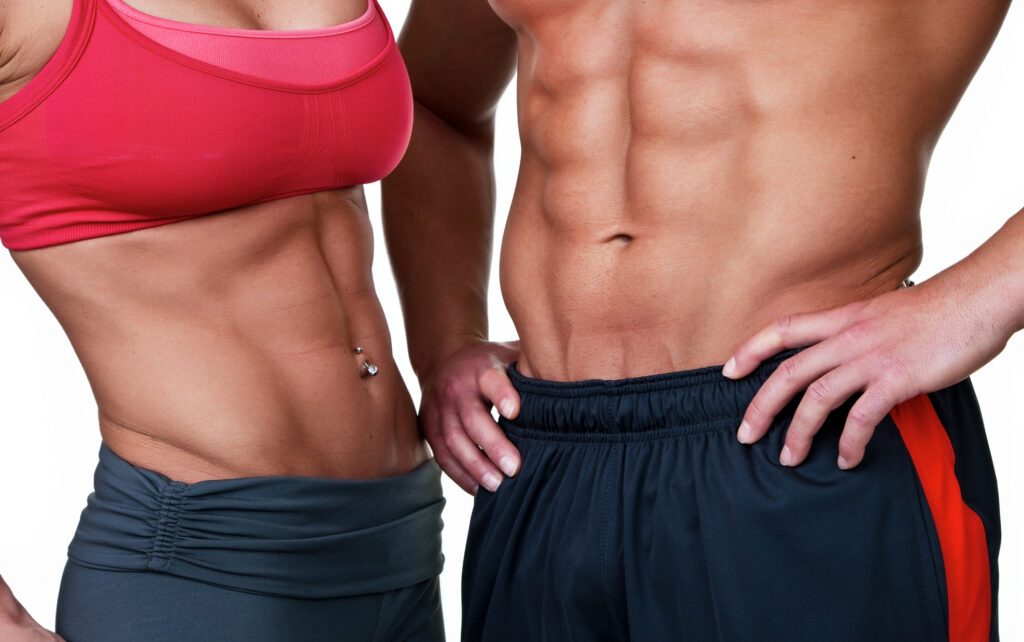By Bob LeFavi, Ph.D., CSCS, CHES
Chances are, if you’re like thousands of fitness-conscious people, you’ll spend a good part of today agonizing over your diet as if the Black Cloud of Fatness was hot on your trail. No doubt you’re betting that through strict dieting, reading labels, relentlessly evaluating and reevaluating your daily meal plan and training routine, you’ll not only avoid those Quasibloato Meets Pillsbury Dough Boy comparisons, but you’ll also slowly expose a ripped, hard and chiseled physique.
But will all that work pay off? I mean, really pay off? After all, in spite of the fact that we’re continually updating our knowledge on the latest research and advances in nutrition and weight loss science, the only thing many people seem to be losing in their fight against fat is ground.
So, something’s not working just right, and I’m beginning to believe the dismal fat-loss success rates of many are the result of confusion. That is, there’s a tendency to get lost in the barrage of weight control “magic bullets” du jour espoused by the media so that we simply become overwhelmed by it all.
What you should know, however, is that the more research we perform and gather on the science of permanent fat loss, the more we’re ruling out the likelihood of a magic bullet (that one incredible fat-loss solution for everyone) altogether. Rather, it makes much more sense to view the most recent research on fat loss in its total framework and to incorporate the latest information into a plan that relates to you; one you can both understand and use. Here are the top 10 theories and more recent revelations dealing with body fat and fat loss that’ll put you in control of your ultimate plan to achieve a ripped physique.
#1. Dietary Fat: The Bad Guy
Whether we want to accept it or not, all calories as not created equal. In other words, it depends where a calorie comes from. Yes, a calorie from fat really is different than a calorie from other sources. And it has nothing to do with the fact that fat has nine calories per gram compared to four for carbs and protein; that;s a separate issue altogether.
Decades of research have shown that fat calories cannot be counted like other calories because they affect your body differently than calories from carbs or protein. Specifically, fat calories, in and of themselves, turn on fat storage mechanisms. To illustrate, take the findings of one study, also shown in animal work, in which the dietary fat content of a group of women trying to lose body fat affected fat loss significantly more than even their total caloric intake1!
Simply put, it’s as if the ingestion of fat itself, regardless of how minimal your total caloric intake may be, is a signal for your body to store fat. This work shows us more than ever that fat’s the culprit (not necessarily calories). And it has led more than a few researchers in nutrition science to suggest that, from a functional point of view, a gram of fat may result in an energy level more like 11 calories!
#2. Dietary Fat: The Good Guy
But, wait; what about the research suggesting dietary fat is not the enemy we once thought it was? Good question. In fact, newer research has provided clues as to how much dietary fat is best for fitness and increasing lean body mass. As it turns out, that’s the better question.
How Low Is Too Low? There is a substantial body of research showing that “to be less fat you must eat less fat,” but can fat intake get too low? When it comes to muscle growth and leanness, the answer appears to be yes!
A study2 by researchers at Penn State University demonstrated that a higher-fat diet might help maintain an athlete’s anabolic potential. This study is built on evidence identifying a decrease in circulating testosterone levels when subjects consumed a diet containing a much lower-than-average percentage of calories from fat. For instance, Reed3 showed that changing the diet of six normal men from one having plentiful fat to one in which the men consumed less than 20 grams of fat per day significantly decreased free testosterone concentrations in their bloodstream. And Tegelman and co-workers reported that when the diets of hockey players shifted from 40% energy from fat to under 30 percent energy from fat, their serum testosterone concentrations were reduced significantly.4
Again, in the Penn State study, the resting testosterone concentrations of 12 weight training men were positively correlated with their percent of energy intake from fat! This means that as these men ate more fat, their anabolic state increased. So what’s the deal?
“Higher Fat.” In the study above, a few things are important. First, when striving to maximize your anabolic state, we’re not talking about high-fat diets, but “higher fat” (higher than extremely low-fat) diets. In the Penn State study, the mean percentage of calories from fat was only 23%! And the highest was only 32%! We’re not anywhere near what you might call, by today’s standards, high fat!
However, these findings have certainly modified our thinking about the limits of a low-fat diet. Yes, you can get too low! Low fat doesn’t mean “the lower, the better.” What we’ve come to see is that changing your diet, and the subsequent physiological alterations to which your body would have to adapt, is a stressor like any other stressor you encounter. As such, your change in dietary fat can be a positive stress (called “eustress”), to which you respond as predicted with no difficulties. Or, in the case of a stressor that’s too intense or too frequent, your change in diet can be a negative stressor (called “distress”), to which your body reacts by actually trying to fight itself.
The Penn State study tells us 25-30% fat calories is low enough if you want to get leaner but also maintain your anabolic state. The study’s low-fat dieters were taking in only 10% of their calories from fat! Hey, that’s a pre-contest diet! And a tough one at that! The bottom line is that fat intake can get too low; keep your fat intake at about 25% (which is still cutting back a good deal for most people). And, if you’re looking for the best type of fat to eat, choose the monounsaturated fats associated with olive oils and the Mediterranean diet.
#3. Genetics I – Picking the Right Parents
Research shows you inherit two things: (a) the number of fat cells you’re born with, and (b) where they’re located. Relax! Even if your folks are on the heavy side, it doesn’t mean you’re doomed! It just gives you an idea of your starting point and what you’re working with.
Unfortunately, life continues to be unfair to us. You see, contrary to muscle cells that can really only increase in size, fat cells can increase in both size and number. And once you’ve got a fat cell, it’s with you for life (barring liposuction, etc.). The upside here is that you can shrink your fat cells to virtually nothing!
#4. Genetics II – The Fat Gene
Researchers at New York City’s Rockefeller University found a genetic mutation in obese mice, a mutation they believe is responsible for the production of a hormone that alters metabolism and keeps the brain from shutting off the feed mode.
So, what does all this have to do with you? “Obesity gene or not, you can control your eating habits,” says Kathryn Parker, RD, LD, a sports nutrition consultant in Gainesville, Florida. “We’re not mice; we can make intelligent food choices regardless of any overfat predisposition we might have. I’d bet there are dozens of great athletes who have a predisposition toward some degree of overfatness, but use knowledge, skill and willpower to offset it.” It still comes down to you and what you do every day.
#5. “Set Point” Shenanigans
This old notion that your body has a predetermined body fat “thermostat” that regulates your level of fatness has not only stood the test of time, but has been revisited with a vengeance. It’s no secret to any veteran of bodybuilding that a dieter’s body resists change, trying to get back to its original weight.
In fact, research5 has confirmed that one’s metabolic rate can slow as much as 15% after only a 10% loss of bodyweight. Imagine the incredibly sluggish metabolism competitive athletes must experience when they typically lose up to 15-20% of their bodyweight!
There are two new things here. First, is our belief regarding where this set point originates. Instead of a genetic determination, our set point is now believed to be under control of more external factors (environment, lifestyle, etc.) and thus, much more able to be altered.6 Clearly, the external factor that can lower your set point more than any other factor is continued exercise. That doesn’t mean once this week and three times next week; it means regular training!
Second, we now believe there are chemical messengers shrinking fat cells that are sent to the brain so hunger is stimulated. This protective mechanism might explain why long-term dieters seem to obsess about food; they are continually being reminded to eat. It’s not just you who feels that way at the end of a contest diet, but knowing what you’re up against should help.
#6. Sluggish Metabolism?
You’ve heard it: “I must have a slow metabolism!” Just an excuse for laziness and overeating, right? Well, maybe not. We’ve always known that metabolic rates can be chronically lower in some people. For example, people who put themselves through “yo-yo” dieting rituals wind up with a metabolic rate that’s adapted to first gear.7
It’s not that metabolism can slow; it’s a matter of how much it can slow. So how much difference is there between people when it comes to their normal caloric furnace? Not much. Metabolic rates rarely vary between individuals by more than 5%. But no, it’s not your imagination; some people really do burn calories as if they’re in overdrive all day.
The key to whether you’re at the high or low metabolic end may lie in how good a “fidgeter” you are. “Fidgeting refers to nonpurposeful or spontaneous movement,” says Dr. Eric Poehlman, a former tenured research professor at the University of Vermont (UVM) College of Medicine in Burlington, Vermont. “And that burns calories, too.”
But can fidgeting really make a difference? “Sure, it can!” says Poehlman. And studies at the National Institutes of Health back him up. It has been shown that fidgeters can burn as many as 800 extra calories a day just bouncing their legs and shifting in their chairs! That’s the equivalent of running about eight miles!
#7. Food on the Brain: NPY and Protein-Rich Diets
Research showing decreased hunger and enhanced fat loss when certain brain chemicals are altered has blown us away. First, Kaye and colleagues found the hormone now believed to be the cause of hunger – neuropeptide Y (NPY). When NPY is present in a critical area of an animal’s brain, hunger is produced no matter how much the animal has recently eaten.
So, how can you use this information to your benefit? Since NPY seems to be more specific to carb intake stimulation than anything else, make sure you reach for low-calorie carbs like pasta, potatoes or fruit when the hunger pangs hit. This will reduce NPY activity and the hunger associated with it. This is completely consistent with the new move to higher protein diets, based on clinical (the thermic effect of protein digestion and the fattening effects if insulin) and anecdotal evidence.
Additionally, prescription drugs, such as Prozac (fluoxetine), collectively termed serotonin reuptake inhibitors (SRIs), and even herbal remedies such as St. John’s Wort, may hold a clue to eating behaviors and permanent fat loss.
#8. Weight Cycling: Going Nowhere Fast
Repeated cycles of weight loss and regain, called “yo-yo” dieting, result in weight regain that occurs very quickly. In fact, in one study, animals required twice the time to lose the same weight during a second period of caloric restriction, and only one-third the time to regain it8! Making matters worse, the final, regained weight is virtually always much higher than the pre-dieting weight.
We used to believe this was all a function of a slowed metabolic rate that continually trained itself to live on less during and following each bout of dieting. Now, we know a key fat storage enzyme, called lipoprotein lipase, whose main mission in life is to store fat, increases in activity and concentration after each bout of the up-down cycle. Bottom line: Don’t let yourself get too heavy after a contest or a long diet; it’ll be harder to take that weight off next time.
#9. Missed Communication
Studies suggest sensors in your small intestine signal the brain not only about how much, but also about what has been eaten! In some people who seem to have difficulty losing fat, this gut-to-brain communication system is off-line.
You can use this work to your advantage by (a) being especially conscious of your level of satiety and, of course, by (b) avoiding the tendency to wolf down food when you’re in a hurry, as this crucial monitoring system won’t have time to kick in.
#10. The Caloric Equation
After all this, you’d think it really doesn’t matter how many calories you eat! Well, unfortunately, it still does. That is, when all is said and done, excess calories are stored as fat; there’s really no way around it. However, on the other side is the fact that if you burn more calories than you ingest, you’ll pull energy from your fat stores and slowly deplete them. Sure, that sounds elementary, but as a bodybuilding judge I can’t tell you how many competitors I’ve seen who simply lost sight of this.
However, the processes of converting carbs, protein and fat into fatty deposits differ dramatically. For carbs to be converted to fatty tissue, roughly 30% of their caloric energy is used in the process itself, and even more for protein. (Of course, fat just slips right in there with little trouble.) Here’s another reason why many people have done well on higher protein diets.
And don’t forget about the exercise side of the equation. Far too many people still mistakenly attempt to reduce body fat the ol’ “no-brainer” way – by dropping their caloric level dangerously low, unwittingly shooting themselves in the foot by slowing their metabolic rates to a crawl.
Dr. Robert “Bob” LeFavi is dean of the Beaufort Campus at the University of South Carolina, Beaufort. Previously, he was professor and head, Department of Health Sciences and Kinesiology at Georgia Southern University (Armstrong Campus), and professor of Sports Medicine at Armstrong Atlantic State University, Savannah, Georgia. LeFavi’s research and published work on training and nutrition have led to interviews on “CBS Evening News,” CNN and “Inside Edition,” and quotes as an expert in The New York Times, San Francisco Chronicle, USA Today, Sports Illustrated and Parade. LeFavi is a former competitive bodybuilder who placed second in his class at the National, USA and North American bodybuilding championships.
References:
1. Sheppard L, AR Kristal and LH Kushi. Weight loss in women participating in a randomized trial of low-fat diets. Amer J Clin Nutr 54:821, 1991.
2. Volek JS, WK Kraemer, JA Bush, T Incledon and M Boetes. Testosterone and cortisol in relationship to dietary nutrients and resistance exercise. JAppl Physiol, 82(1):49-54, 1997.
3. Reed MJ, RW Cheng, M Simmonds, W Richmond and VHT James. Dietary lipids: An additional regulator of plasma levels of sex hormone binding globulin. J Clin Endocrinol & Metab, 64(5):1083-1085, 1987.
4. Tegelman R, T Aberg, A Pousette and K. Carlstrom. Effects of a diet regimen on pituitary and steroid hormones in male ice hockey players. Int’l J Sports Med 13:424-430, 1992.
5. Leibel RL, M Rosenbaum and J Hirsch. Changes in energy expenditure resulting from altered body weight. New Eng J Med. 332:621, 1995.
6. Bennett WI. Beyond Overating [Editorial] New Eng J Med. 332:673, 1995.
7. Van Dale D and WHM Saris. Repetitive weight loss and weight regain: Effects on weight reduction, resting metabolic rate, and lipolytic activity before and after exercise and/or diet treatment. Amer J Clin Nutr. 49:409, 1989.
8. Brownell KD, et al. The effects of repeated cycles of weight loss and regain in rats. Physiolog Behav 38:459, 1986.
The post Top 10 Fat-Loss Breakthroughs first appeared on FitnessRX for Women.





